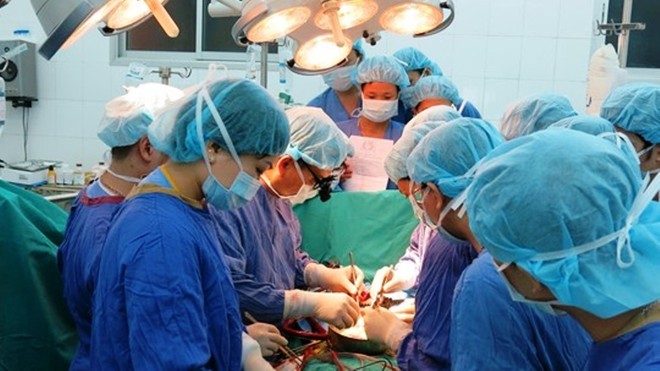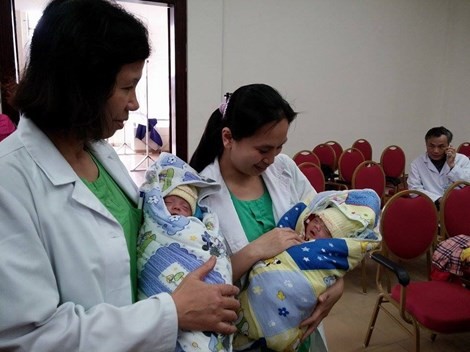(VOVworld) – Vietnam’s medical sector has seen great progress over the years in the quality of its medical diagnosis and treatment, personnel qualifications, and application of advanced treatment technologies. VOV’s Van Hai reviews the achievements, determination, and initiatives of the sector over the last year.

Doctors at Hanoi-based Vietnam-Germany Hospital conduct a heart transplant right after receiving a heart that traveled 1,700km from Ho Chi Minh City to Hanoi.
(Photo: vietnamnet.vn)
|
Last year Vietnamese doctors transplanted a heart and liver taken from a dead person in Ho Chi Minh City to two patients in Hanoi.
Vietnam has performed many organ transplants in recent years but this was the first time doctors of the Vietnam-Germany Hospital in Hanoi obtained donated organs from HCM City, the longest organ transportation in Vietnam so far.
Professor Trinh Hong Son, the hospital’s deputy director, recalls “we put the organs into a special container of medical solution. But the box was too big for the passengers’ luggage bins. We persuaded the pilot to put it near his seat so that from time to time we could add more organ maintenance solution.”
Vietnam’s obstetrics sector also recorded many outstanding achievements last year. Ho Chi Minh City’s Tu Du Hospital and the National Hospital of Obstetrics and Gynecology in Hanoi declared the first successful surrogate pregnancy.
Their techniques have proven Vietnamese doctors’ qualifications and the sector’s contributions to the development and enforcement of the law on surrogate pregnancy.
Doctors from Hanoi’s Bach Mai Hospital successfully treated a patient who had suffered from kidney failure for seven years before giving birth to a baby boy. Doctors from the National Hospital of Obstetrics and Gynecology in Hanoi nurtured a pair of premature twins who weighed about 500 grams at birth.
 |
| On March 10 when they were released from the hospital, the girl Giang Thien Bao, weighed 2.3kg and the boy, Giang Thien An, 2.2 kg. (Photo: hanoitimes.com.vn) |
Doctor Nguyen Ngoc Loi, the director of the Center for Premature Infant Care and Treatment at the National Hospital of Obstetrics and Gynecology, said “asepsis is the top priority in taking care of infants, followed by nutrition, equipment, and medicine. All steps should be meticulous. Medical workers must be on guard around the clock. Breathing suspension for 20 seconds can endanger their lives. In fact we have just 80 workers-not the 216 workers the regulations require- so we have to work very hard to handle the daily huge volume of work. With 200 beds crowded into 1 square kilometer, each year we receive up to 2,500 infants suffering from serious diseases. 10% of them are premature babies who have contracted one or more diseases.”
In 2015 the Vietnam-Germany Hospital performed titanium vertebra replacement for patients suffering from spinal column-related diseases, patients with spinal metastatic tumors, and patients with spinal cord trauma leading to vertebral fractures. It is one of the latest techniques in the world medicine.
Doctor Do Manh Hung of the Orthopedics-Trauma Department of the Vietnam-Germany Hospital has been presented with the 2015 Young Science Talent Award. He said his project “was based on my observation that in order to lock a lock, we must put the key in and turn the key it clockwise and to unlock the lock, it’s necessary to turn the key counterclockwise. We apply this same principle to the treatment of trauma and spinal cord injury.”
Vietnamese medical achievements should include the success of doctors at Military Central Hospital 108 and Bach Mai Hospital in Hanoi who have applied a new method – an interventional radiology treatment using intra-arterial yttrium-90 (Y-90) microspheres – in cancer treatment.
 |
| In this file photo, a liver cancer patient is being treated at the Oncology Hospital in HCMC. (Photo: Tuoi Tre) |
Yttrium-90 microspheres are introduced into the artery that leads to the tumor. When they are close to the tumor, these microspheres generate radioactive rays that kill the tumor’s cancerous cells. These microspheres also prevent blood from circulating to the tumor, cutting off its source of nutrients, thus killing the tumor. The microspheres target only cancerous cells and have no effect on normal cells.